CME204 Building Services: Fire Risk Assessment for Three Tenancies
VerifiedAdded on 2021/05/31
|13
|4193
|92
Report
AI Summary
This report presents a fire risk assessment for three commercial tenancies: Looksmart Alterations, Diamond Nail, and Espresso Pump, incorporating elements from the CME204 Building Services unit. The assessment evaluates fire hazards and safety equipment, including automatic sprinkler systems, fire detection and alarm systems, and dampers, considering the Building Code of Australia (BCA) regulations. It details the system requirements for each tenancy, such as sprinkler systems for garment shops, fire detection with CO2 extinguishers for nail salons, and dampers for coffee shops. The report emphasizes preventive measures and escape strategies for occupants, adhering to sustainable building principles and relevant standards. The report's objective is to determine the suitability of physical fire precautionary measures and structural design of the fire compartment, also including the integration of fire protection systems with other devices, to safeguard against fire hazards.
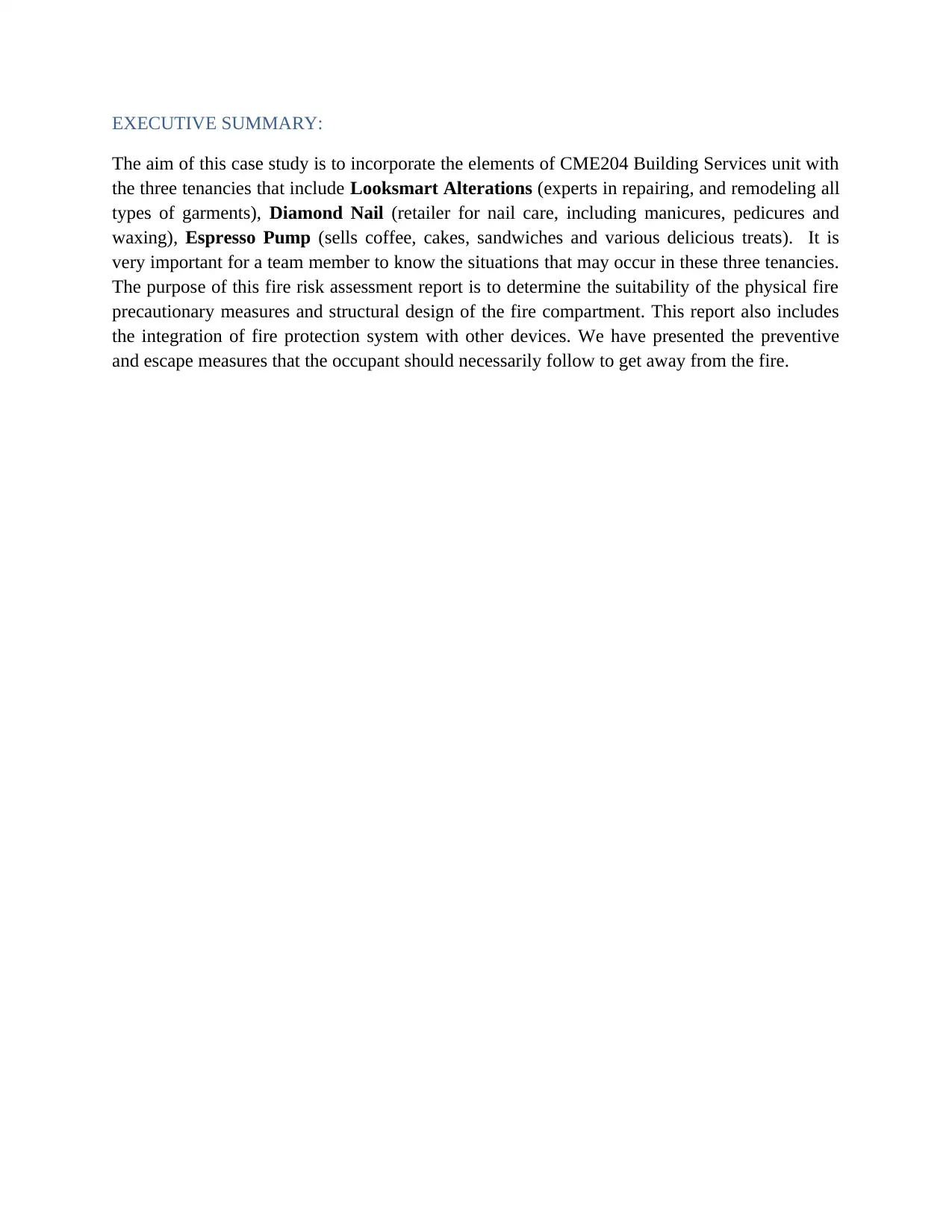
EXECUTIVE SUMMARY:
The aim of this case study is to incorporate the elements of CME204 Building Services unit with
the three tenancies that include Looksmart Alterations (experts in repairing, and remodeling all
types of garments), Diamond Nail (retailer for nail care, including manicures, pedicures and
waxing), Espresso Pump (sells coffee, cakes, sandwiches and various delicious treats). It is
very important for a team member to know the situations that may occur in these three tenancies.
The purpose of this fire risk assessment report is to determine the suitability of the physical fire
precautionary measures and structural design of the fire compartment. This report also includes
the integration of fire protection system with other devices. We have presented the preventive
and escape measures that the occupant should necessarily follow to get away from the fire.
The aim of this case study is to incorporate the elements of CME204 Building Services unit with
the three tenancies that include Looksmart Alterations (experts in repairing, and remodeling all
types of garments), Diamond Nail (retailer for nail care, including manicures, pedicures and
waxing), Espresso Pump (sells coffee, cakes, sandwiches and various delicious treats). It is
very important for a team member to know the situations that may occur in these three tenancies.
The purpose of this fire risk assessment report is to determine the suitability of the physical fire
precautionary measures and structural design of the fire compartment. This report also includes
the integration of fire protection system with other devices. We have presented the preventive
and escape measures that the occupant should necessarily follow to get away from the fire.
Paraphrase This Document
Need a fresh take? Get an instant paraphrase of this document with our AI Paraphraser
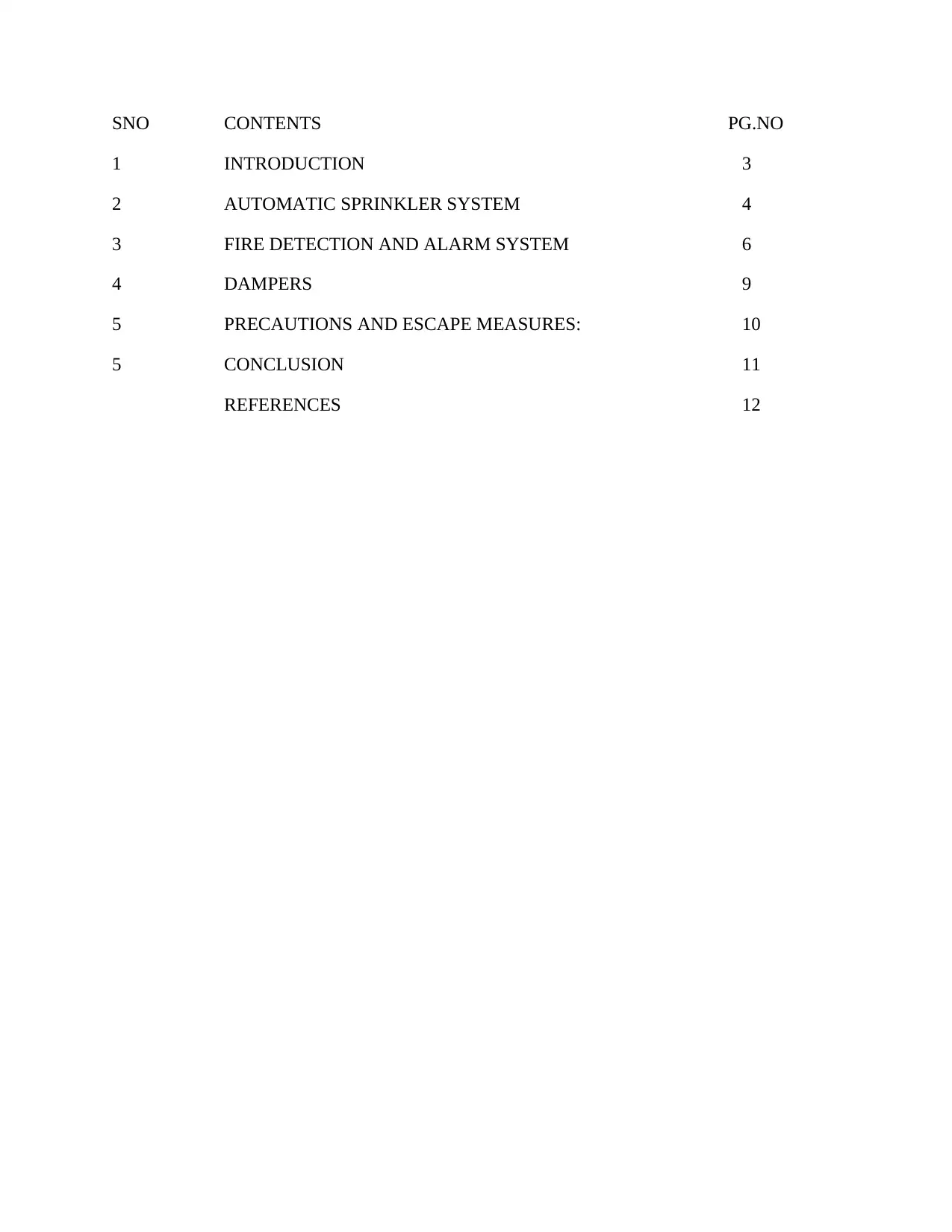
SNO CONTENTS PG.NO
1 INTRODUCTION 3
2 AUTOMATIC SPRINKLER SYSTEM 4
3 FIRE DETECTION AND ALARM SYSTEM 6
4 DAMPERS 9
5 PRECAUTIONS AND ESCAPE MEASURES: 10
5 CONCLUSION 11
REFERENCES 12
1 INTRODUCTION 3
2 AUTOMATIC SPRINKLER SYSTEM 4
3 FIRE DETECTION AND ALARM SYSTEM 6
4 DAMPERS 9
5 PRECAUTIONS AND ESCAPE MEASURES: 10
5 CONCLUSION 11
REFERENCES 12
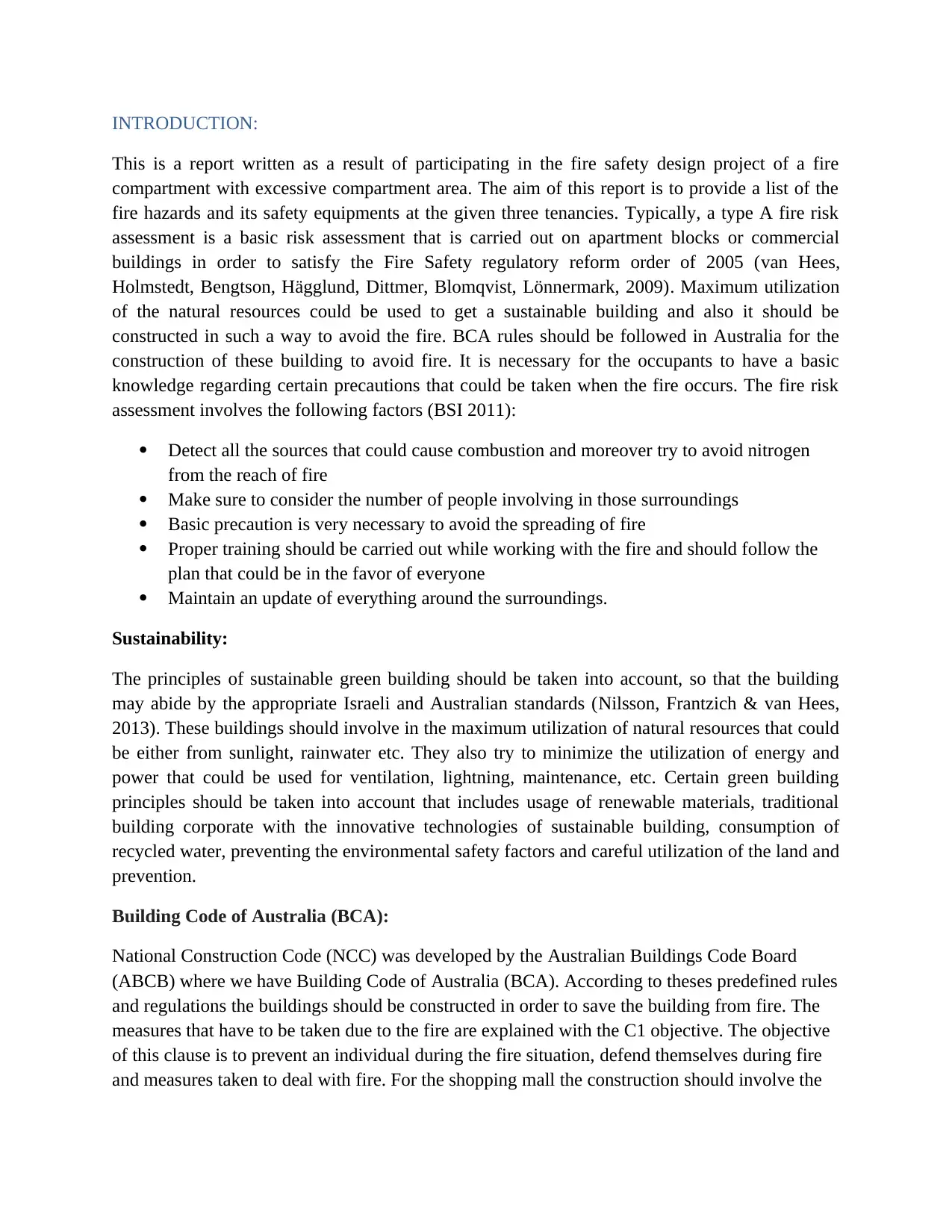
INTRODUCTION:
This is a report written as a result of participating in the fire safety design project of a fire
compartment with excessive compartment area. The aim of this report is to provide a list of the
fire hazards and its safety equipments at the given three tenancies. Typically, a type A fire risk
assessment is a basic risk assessment that is carried out on apartment blocks or commercial
buildings in order to satisfy the Fire Safety regulatory reform order of 2005 (van Hees,
Holmstedt, Bengtson, Hägglund, Dittmer, Blomqvist, Lönnermark, 2009). Maximum utilization
of the natural resources could be used to get a sustainable building and also it should be
constructed in such a way to avoid the fire. BCA rules should be followed in Australia for the
construction of these building to avoid fire. It is necessary for the occupants to have a basic
knowledge regarding certain precautions that could be taken when the fire occurs. The fire risk
assessment involves the following factors (BSI 2011):
Detect all the sources that could cause combustion and moreover try to avoid nitrogen
from the reach of fire
Make sure to consider the number of people involving in those surroundings
Basic precaution is very necessary to avoid the spreading of fire
Proper training should be carried out while working with the fire and should follow the
plan that could be in the favor of everyone
Maintain an update of everything around the surroundings.
Sustainability:
The principles of sustainable green building should be taken into account, so that the building
may abide by the appropriate Israeli and Australian standards (Nilsson, Frantzich & van Hees,
2013). These buildings should involve in the maximum utilization of natural resources that could
be either from sunlight, rainwater etc. They also try to minimize the utilization of energy and
power that could be used for ventilation, lightning, maintenance, etc. Certain green building
principles should be taken into account that includes usage of renewable materials, traditional
building corporate with the innovative technologies of sustainable building, consumption of
recycled water, preventing the environmental safety factors and careful utilization of the land and
prevention.
Building Code of Australia (BCA):
National Construction Code (NCC) was developed by the Australian Buildings Code Board
(ABCB) where we have Building Code of Australia (BCA). According to theses predefined rules
and regulations the buildings should be constructed in order to save the building from fire. The
measures that have to be taken due to the fire are explained with the C1 objective. The objective
of this clause is to prevent an individual during the fire situation, defend themselves during fire
and measures taken to deal with fire. For the shopping mall the construction should involve the
This is a report written as a result of participating in the fire safety design project of a fire
compartment with excessive compartment area. The aim of this report is to provide a list of the
fire hazards and its safety equipments at the given three tenancies. Typically, a type A fire risk
assessment is a basic risk assessment that is carried out on apartment blocks or commercial
buildings in order to satisfy the Fire Safety regulatory reform order of 2005 (van Hees,
Holmstedt, Bengtson, Hägglund, Dittmer, Blomqvist, Lönnermark, 2009). Maximum utilization
of the natural resources could be used to get a sustainable building and also it should be
constructed in such a way to avoid the fire. BCA rules should be followed in Australia for the
construction of these building to avoid fire. It is necessary for the occupants to have a basic
knowledge regarding certain precautions that could be taken when the fire occurs. The fire risk
assessment involves the following factors (BSI 2011):
Detect all the sources that could cause combustion and moreover try to avoid nitrogen
from the reach of fire
Make sure to consider the number of people involving in those surroundings
Basic precaution is very necessary to avoid the spreading of fire
Proper training should be carried out while working with the fire and should follow the
plan that could be in the favor of everyone
Maintain an update of everything around the surroundings.
Sustainability:
The principles of sustainable green building should be taken into account, so that the building
may abide by the appropriate Israeli and Australian standards (Nilsson, Frantzich & van Hees,
2013). These buildings should involve in the maximum utilization of natural resources that could
be either from sunlight, rainwater etc. They also try to minimize the utilization of energy and
power that could be used for ventilation, lightning, maintenance, etc. Certain green building
principles should be taken into account that includes usage of renewable materials, traditional
building corporate with the innovative technologies of sustainable building, consumption of
recycled water, preventing the environmental safety factors and careful utilization of the land and
prevention.
Building Code of Australia (BCA):
National Construction Code (NCC) was developed by the Australian Buildings Code Board
(ABCB) where we have Building Code of Australia (BCA). According to theses predefined rules
and regulations the buildings should be constructed in order to save the building from fire. The
measures that have to be taken due to the fire are explained with the C1 objective. The objective
of this clause is to prevent an individual during the fire situation, defend themselves during fire
and measures taken to deal with fire. For the shopping mall the construction should involve the
⊘ This is a preview!⊘
Do you want full access?
Subscribe today to unlock all pages.

Trusted by 1+ million students worldwide
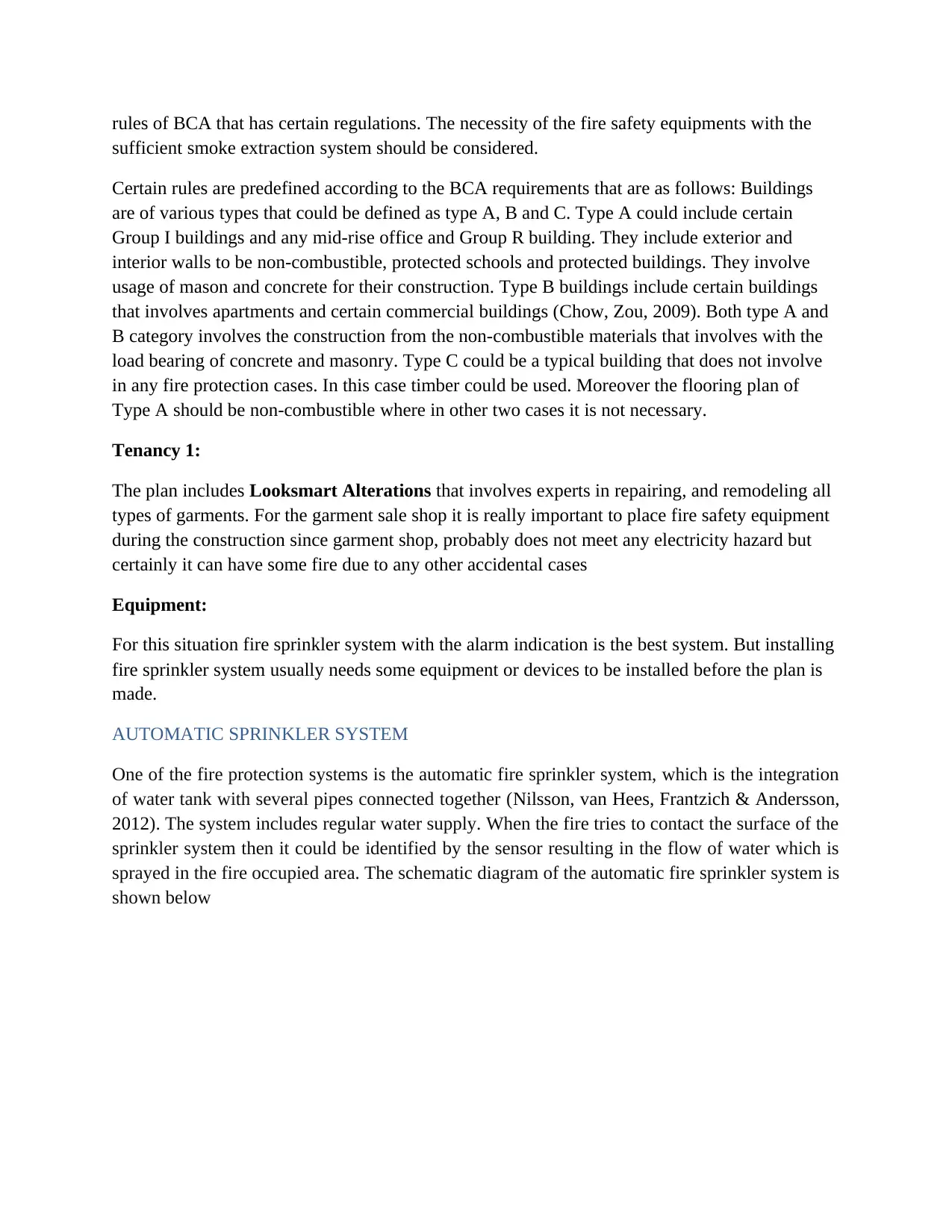
rules of BCA that has certain regulations. The necessity of the fire safety equipments with the
sufficient smoke extraction system should be considered.
Certain rules are predefined according to the BCA requirements that are as follows: Buildings
are of various types that could be defined as type A, B and C. Type A could include certain
Group I buildings and any mid-rise office and Group R building. They include exterior and
interior walls to be non-combustible, protected schools and protected buildings. They involve
usage of mason and concrete for their construction. Type B buildings include certain buildings
that involves apartments and certain commercial buildings (Chow, Zou, 2009). Both type A and
B category involves the construction from the non-combustible materials that involves with the
load bearing of concrete and masonry. Type C could be a typical building that does not involve
in any fire protection cases. In this case timber could be used. Moreover the flooring plan of
Type A should be non-combustible where in other two cases it is not necessary.
Tenancy 1:
The plan includes Looksmart Alterations that involves experts in repairing, and remodeling all
types of garments. For the garment sale shop it is really important to place fire safety equipment
during the construction since garment shop, probably does not meet any electricity hazard but
certainly it can have some fire due to any other accidental cases
Equipment:
For this situation fire sprinkler system with the alarm indication is the best system. But installing
fire sprinkler system usually needs some equipment or devices to be installed before the plan is
made.
AUTOMATIC SPRINKLER SYSTEM
One of the fire protection systems is the automatic fire sprinkler system, which is the integration
of water tank with several pipes connected together (Nilsson, van Hees, Frantzich & Andersson,
2012). The system includes regular water supply. When the fire tries to contact the surface of the
sprinkler system then it could be identified by the sensor resulting in the flow of water which is
sprayed in the fire occupied area. The schematic diagram of the automatic fire sprinkler system is
shown below
sufficient smoke extraction system should be considered.
Certain rules are predefined according to the BCA requirements that are as follows: Buildings
are of various types that could be defined as type A, B and C. Type A could include certain
Group I buildings and any mid-rise office and Group R building. They include exterior and
interior walls to be non-combustible, protected schools and protected buildings. They involve
usage of mason and concrete for their construction. Type B buildings include certain buildings
that involves apartments and certain commercial buildings (Chow, Zou, 2009). Both type A and
B category involves the construction from the non-combustible materials that involves with the
load bearing of concrete and masonry. Type C could be a typical building that does not involve
in any fire protection cases. In this case timber could be used. Moreover the flooring plan of
Type A should be non-combustible where in other two cases it is not necessary.
Tenancy 1:
The plan includes Looksmart Alterations that involves experts in repairing, and remodeling all
types of garments. For the garment sale shop it is really important to place fire safety equipment
during the construction since garment shop, probably does not meet any electricity hazard but
certainly it can have some fire due to any other accidental cases
Equipment:
For this situation fire sprinkler system with the alarm indication is the best system. But installing
fire sprinkler system usually needs some equipment or devices to be installed before the plan is
made.
AUTOMATIC SPRINKLER SYSTEM
One of the fire protection systems is the automatic fire sprinkler system, which is the integration
of water tank with several pipes connected together (Nilsson, van Hees, Frantzich & Andersson,
2012). The system includes regular water supply. When the fire tries to contact the surface of the
sprinkler system then it could be identified by the sensor resulting in the flow of water which is
sprayed in the fire occupied area. The schematic diagram of the automatic fire sprinkler system is
shown below
Paraphrase This Document
Need a fresh take? Get an instant paraphrase of this document with our AI Paraphraser
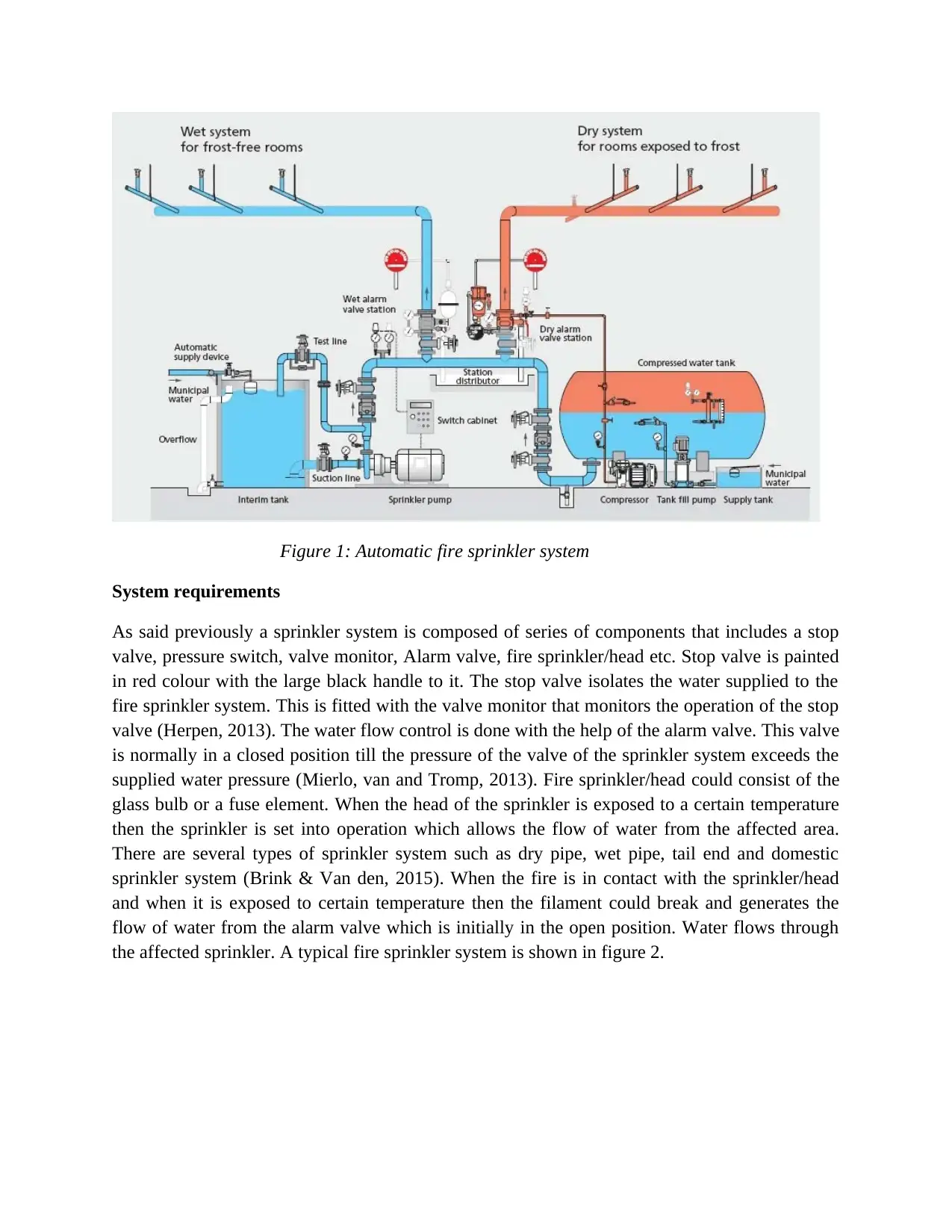
Figure 1: Automatic fire sprinkler system
System requirements
As said previously a sprinkler system is composed of series of components that includes a stop
valve, pressure switch, valve monitor, Alarm valve, fire sprinkler/head etc. Stop valve is painted
in red colour with the large black handle to it. The stop valve isolates the water supplied to the
fire sprinkler system. This is fitted with the valve monitor that monitors the operation of the stop
valve (Herpen, 2013). The water flow control is done with the help of the alarm valve. This valve
is normally in a closed position till the pressure of the valve of the sprinkler system exceeds the
supplied water pressure (Mierlo, van and Tromp, 2013). Fire sprinkler/head could consist of the
glass bulb or a fuse element. When the head of the sprinkler is exposed to a certain temperature
then the sprinkler is set into operation which allows the flow of water from the affected area.
There are several types of sprinkler system such as dry pipe, wet pipe, tail end and domestic
sprinkler system (Brink & Van den, 2015). When the fire is in contact with the sprinkler/head
and when it is exposed to certain temperature then the filament could break and generates the
flow of water from the alarm valve which is initially in the open position. Water flows through
the affected sprinkler. A typical fire sprinkler system is shown in figure 2.
System requirements
As said previously a sprinkler system is composed of series of components that includes a stop
valve, pressure switch, valve monitor, Alarm valve, fire sprinkler/head etc. Stop valve is painted
in red colour with the large black handle to it. The stop valve isolates the water supplied to the
fire sprinkler system. This is fitted with the valve monitor that monitors the operation of the stop
valve (Herpen, 2013). The water flow control is done with the help of the alarm valve. This valve
is normally in a closed position till the pressure of the valve of the sprinkler system exceeds the
supplied water pressure (Mierlo, van and Tromp, 2013). Fire sprinkler/head could consist of the
glass bulb or a fuse element. When the head of the sprinkler is exposed to a certain temperature
then the sprinkler is set into operation which allows the flow of water from the affected area.
There are several types of sprinkler system such as dry pipe, wet pipe, tail end and domestic
sprinkler system (Brink & Van den, 2015). When the fire is in contact with the sprinkler/head
and when it is exposed to certain temperature then the filament could break and generates the
flow of water from the alarm valve which is initially in the open position. Water flows through
the affected sprinkler. A typical fire sprinkler system is shown in figure 2.

Figure 2: Typical automatic fire sprinkler system
Tenancy 2:
Here we have the ground floor that includes Diamond Nail a retailer for nail care, including
manicures, pedicures and waxing. There is a main point to remember that while working with the
pedicure, waxing or manicure everything has an involvement of heat. They use electricity for
heating process and moreover these could cause fire which has to be considered and the basic
fire extinguishers should be installed. It is necessary to maintain the record of the amount of
staffs working in that environment and the activities performed by them should be monitored.
Equipment:
For this tenancy the fire detection and alarm circuit is the best plan. This should be incorporated
with the CO2 extinguishers to avoid spreading of fire.
FIRE DETECTION AND ALARM SYSTEM:
It has been proved that huge loss could be avoided initially when we have a detection
system to detect the fire at the early stage and give a warning sign. A fire detector and alarm
system helps us with this indication (Proulx, 2008). The Maintenance is very essential and the
fire suppression system (Rubin, Brewin, Greenberg, Hughes, Simpson & Wessely, 2007) along
with the fire detection and alarm system plays a major role in the fire protection system. This
could make the survival of the living and also protect from heavy property damage. Fire could
spread from the ground floor to the top floor in a multifunctional building. Hence precautions
should be taken at the beginning. The people who are trained in these aspects should serve the
maintenance purpose.
Tenancy 2:
Here we have the ground floor that includes Diamond Nail a retailer for nail care, including
manicures, pedicures and waxing. There is a main point to remember that while working with the
pedicure, waxing or manicure everything has an involvement of heat. They use electricity for
heating process and moreover these could cause fire which has to be considered and the basic
fire extinguishers should be installed. It is necessary to maintain the record of the amount of
staffs working in that environment and the activities performed by them should be monitored.
Equipment:
For this tenancy the fire detection and alarm circuit is the best plan. This should be incorporated
with the CO2 extinguishers to avoid spreading of fire.
FIRE DETECTION AND ALARM SYSTEM:
It has been proved that huge loss could be avoided initially when we have a detection
system to detect the fire at the early stage and give a warning sign. A fire detector and alarm
system helps us with this indication (Proulx, 2008). The Maintenance is very essential and the
fire suppression system (Rubin, Brewin, Greenberg, Hughes, Simpson & Wessely, 2007) along
with the fire detection and alarm system plays a major role in the fire protection system. This
could make the survival of the living and also protect from heavy property damage. Fire could
spread from the ground floor to the top floor in a multifunctional building. Hence precautions
should be taken at the beginning. The people who are trained in these aspects should serve the
maintenance purpose.
⊘ This is a preview!⊘
Do you want full access?
Subscribe today to unlock all pages.

Trusted by 1+ million students worldwide
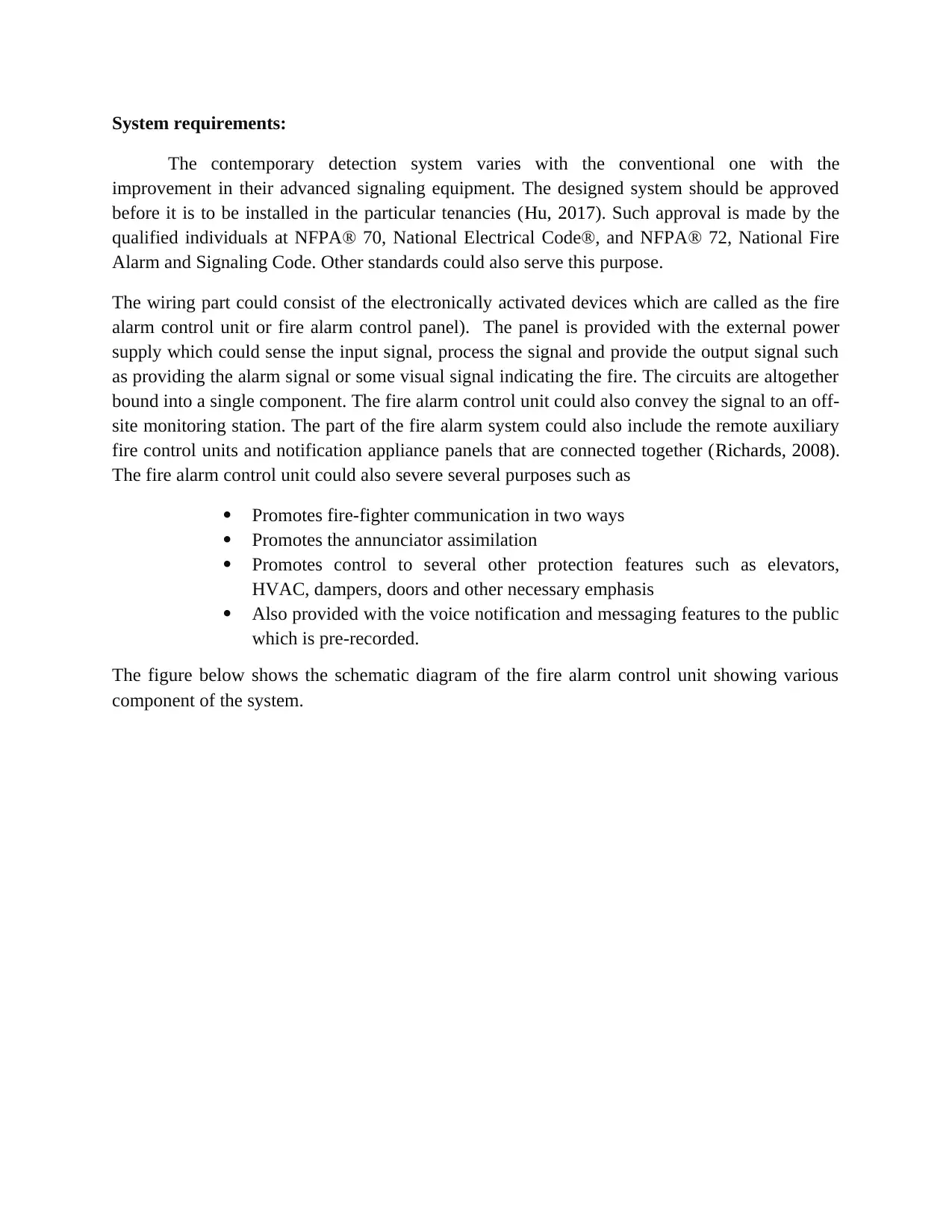
System requirements:
The contemporary detection system varies with the conventional one with the
improvement in their advanced signaling equipment. The designed system should be approved
before it is to be installed in the particular tenancies (Hu, 2017). Such approval is made by the
qualified individuals at NFPA® 70, National Electrical Code®, and NFPA® 72, National Fire
Alarm and Signaling Code. Other standards could also serve this purpose.
The wiring part could consist of the electronically activated devices which are called as the fire
alarm control unit or fire alarm control panel). The panel is provided with the external power
supply which could sense the input signal, process the signal and provide the output signal such
as providing the alarm signal or some visual signal indicating the fire. The circuits are altogether
bound into a single component. The fire alarm control unit could also convey the signal to an off-
site monitoring station. The part of the fire alarm system could also include the remote auxiliary
fire control units and notification appliance panels that are connected together (Richards, 2008).
The fire alarm control unit could also severe several purposes such as
Promotes fire-fighter communication in two ways
Promotes the annunciator assimilation
Promotes control to several other protection features such as elevators,
HVAC, dampers, doors and other necessary emphasis
Also provided with the voice notification and messaging features to the public
which is pre-recorded.
The figure below shows the schematic diagram of the fire alarm control unit showing various
component of the system.
The contemporary detection system varies with the conventional one with the
improvement in their advanced signaling equipment. The designed system should be approved
before it is to be installed in the particular tenancies (Hu, 2017). Such approval is made by the
qualified individuals at NFPA® 70, National Electrical Code®, and NFPA® 72, National Fire
Alarm and Signaling Code. Other standards could also serve this purpose.
The wiring part could consist of the electronically activated devices which are called as the fire
alarm control unit or fire alarm control panel). The panel is provided with the external power
supply which could sense the input signal, process the signal and provide the output signal such
as providing the alarm signal or some visual signal indicating the fire. The circuits are altogether
bound into a single component. The fire alarm control unit could also convey the signal to an off-
site monitoring station. The part of the fire alarm system could also include the remote auxiliary
fire control units and notification appliance panels that are connected together (Richards, 2008).
The fire alarm control unit could also severe several purposes such as
Promotes fire-fighter communication in two ways
Promotes the annunciator assimilation
Promotes control to several other protection features such as elevators,
HVAC, dampers, doors and other necessary emphasis
Also provided with the voice notification and messaging features to the public
which is pre-recorded.
The figure below shows the schematic diagram of the fire alarm control unit showing various
component of the system.
Paraphrase This Document
Need a fresh take? Get an instant paraphrase of this document with our AI Paraphraser
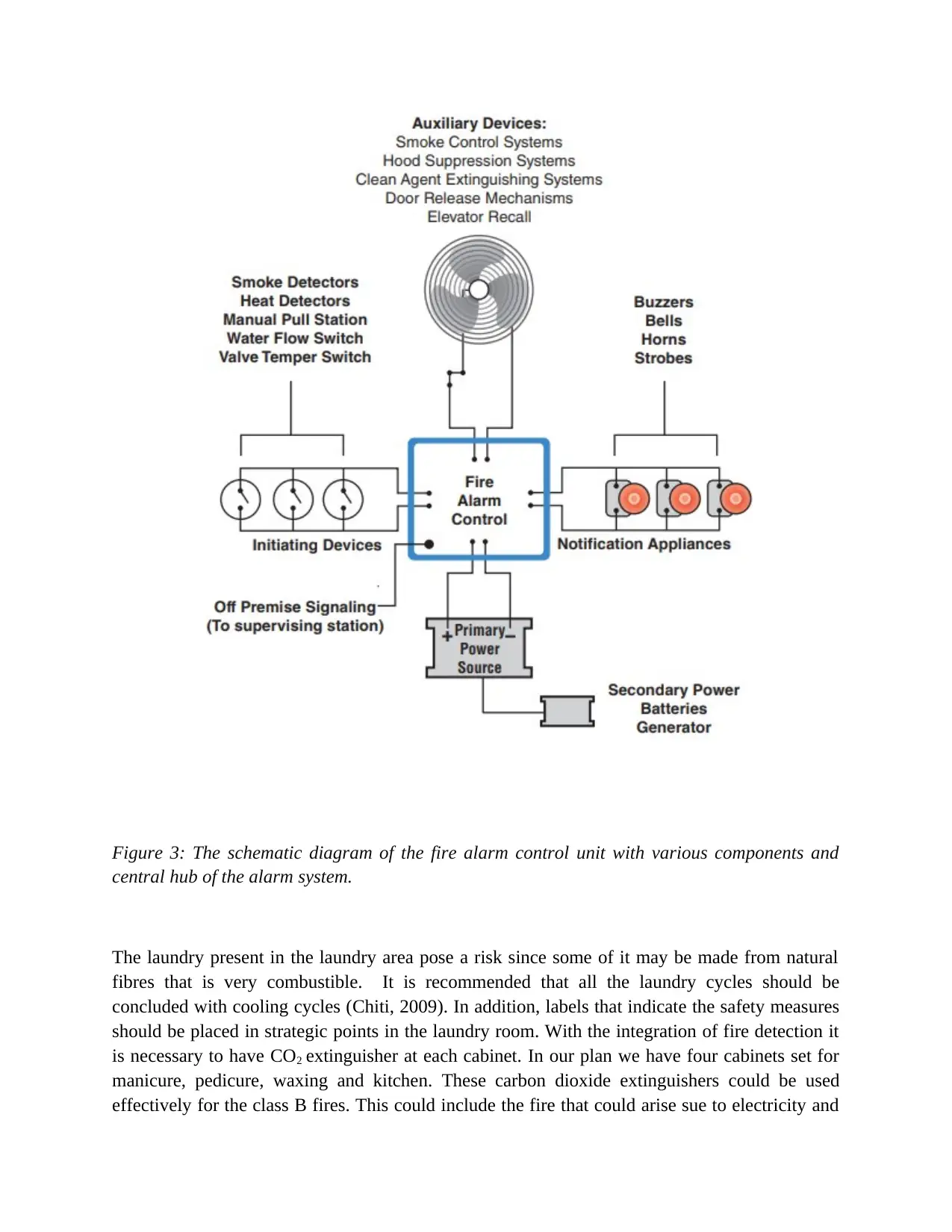
Figure 3: The schematic diagram of the fire alarm control unit with various components and
central hub of the alarm system.
The laundry present in the laundry area pose a risk since some of it may be made from natural
fibres that is very combustible. It is recommended that all the laundry cycles should be
concluded with cooling cycles (Chiti, 2009). In addition, labels that indicate the safety measures
should be placed in strategic points in the laundry room. With the integration of fire detection it
is necessary to have CO2 extinguisher at each cabinet. In our plan we have four cabinets set for
manicure, pedicure, waxing and kitchen. These carbon dioxide extinguishers could be used
effectively for the class B fires. This could include the fire that could arise sue to electricity and
central hub of the alarm system.
The laundry present in the laundry area pose a risk since some of it may be made from natural
fibres that is very combustible. It is recommended that all the laundry cycles should be
concluded with cooling cycles (Chiti, 2009). In addition, labels that indicate the safety measures
should be placed in strategic points in the laundry room. With the integration of fire detection it
is necessary to have CO2 extinguisher at each cabinet. In our plan we have four cabinets set for
manicure, pedicure, waxing and kitchen. These carbon dioxide extinguishers could be used
effectively for the class B fires. This could include the fire that could arise sue to electricity and
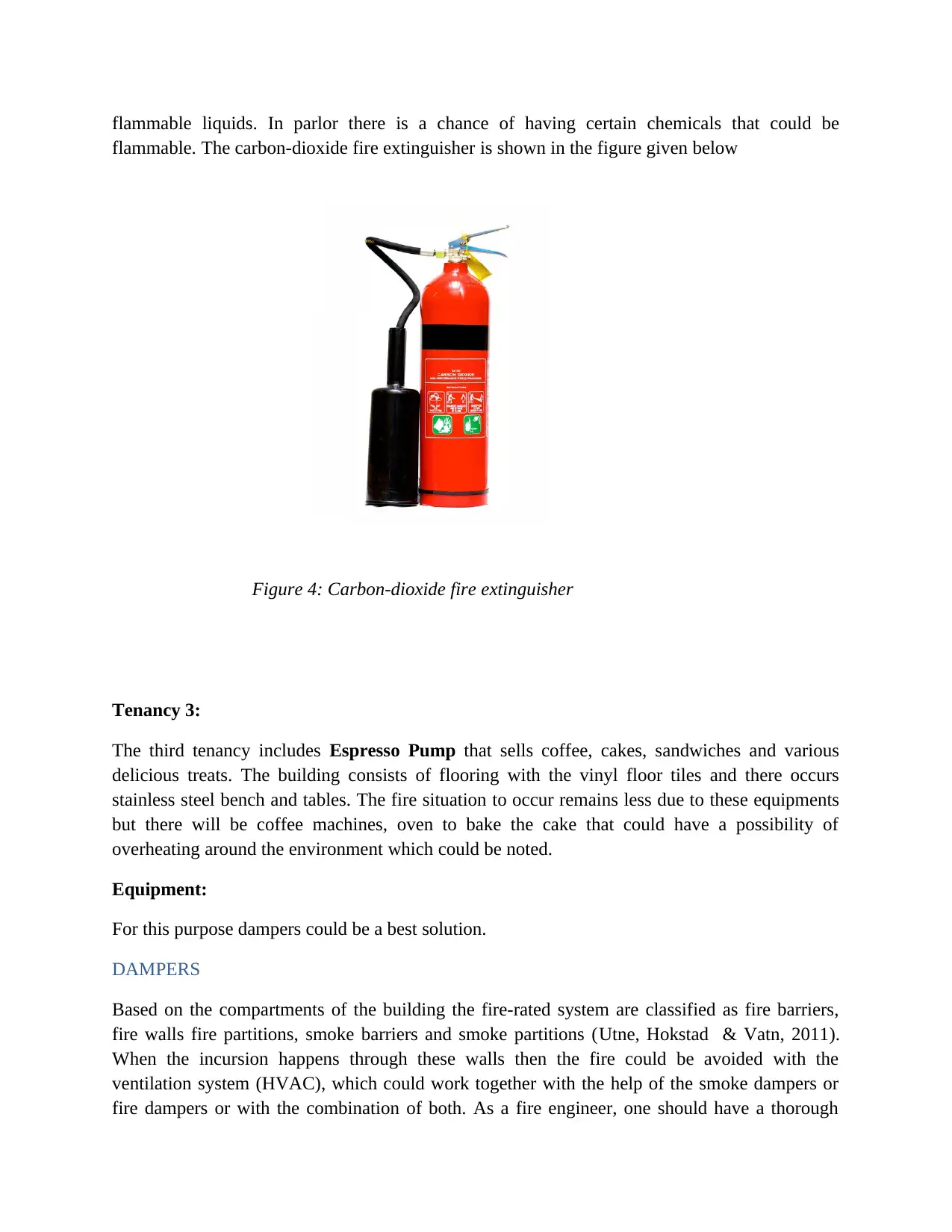
flammable liquids. In parlor there is a chance of having certain chemicals that could be
flammable. The carbon-dioxide fire extinguisher is shown in the figure given below
Figure 4: Carbon-dioxide fire extinguisher
Tenancy 3:
The third tenancy includes Espresso Pump that sells coffee, cakes, sandwiches and various
delicious treats. The building consists of flooring with the vinyl floor tiles and there occurs
stainless steel bench and tables. The fire situation to occur remains less due to these equipments
but there will be coffee machines, oven to bake the cake that could have a possibility of
overheating around the environment which could be noted.
Equipment:
For this purpose dampers could be a best solution.
DAMPERS
Based on the compartments of the building the fire-rated system are classified as fire barriers,
fire walls fire partitions, smoke barriers and smoke partitions (Utne, Hokstad & Vatn, 2011).
When the incursion happens through these walls then the fire could be avoided with the
ventilation system (HVAC), which could work together with the help of the smoke dampers or
fire dampers or with the combination of both. As a fire engineer, one should have a thorough
flammable. The carbon-dioxide fire extinguisher is shown in the figure given below
Figure 4: Carbon-dioxide fire extinguisher
Tenancy 3:
The third tenancy includes Espresso Pump that sells coffee, cakes, sandwiches and various
delicious treats. The building consists of flooring with the vinyl floor tiles and there occurs
stainless steel bench and tables. The fire situation to occur remains less due to these equipments
but there will be coffee machines, oven to bake the cake that could have a possibility of
overheating around the environment which could be noted.
Equipment:
For this purpose dampers could be a best solution.
DAMPERS
Based on the compartments of the building the fire-rated system are classified as fire barriers,
fire walls fire partitions, smoke barriers and smoke partitions (Utne, Hokstad & Vatn, 2011).
When the incursion happens through these walls then the fire could be avoided with the
ventilation system (HVAC), which could work together with the help of the smoke dampers or
fire dampers or with the combination of both. As a fire engineer, one should have a thorough
⊘ This is a preview!⊘
Do you want full access?
Subscribe today to unlock all pages.

Trusted by 1+ million students worldwide
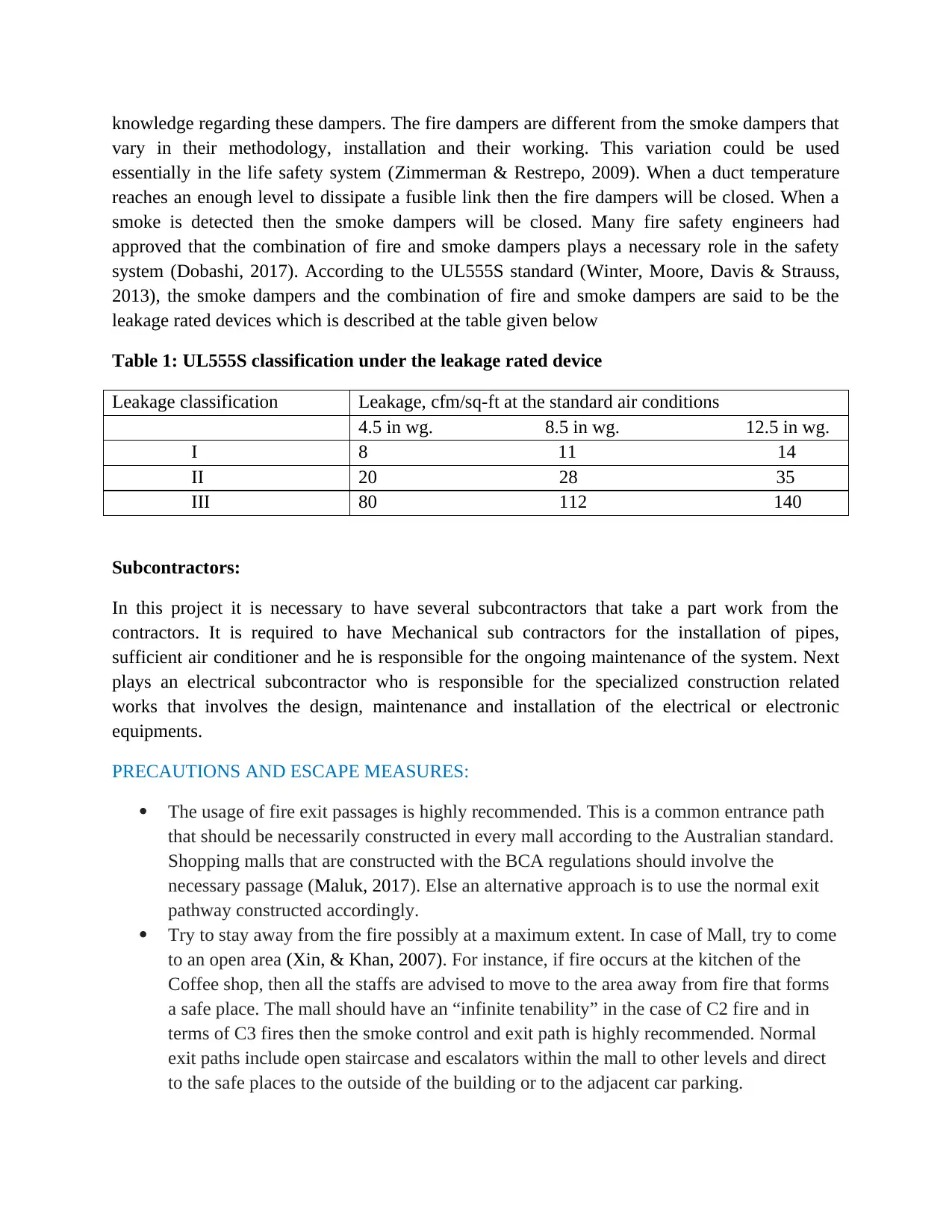
knowledge regarding these dampers. The fire dampers are different from the smoke dampers that
vary in their methodology, installation and their working. This variation could be used
essentially in the life safety system (Zimmerman & Restrepo, 2009). When a duct temperature
reaches an enough level to dissipate a fusible link then the fire dampers will be closed. When a
smoke is detected then the smoke dampers will be closed. Many fire safety engineers had
approved that the combination of fire and smoke dampers plays a necessary role in the safety
system (Dobashi, 2017). According to the UL555S standard (Winter, Moore, Davis & Strauss,
2013), the smoke dampers and the combination of fire and smoke dampers are said to be the
leakage rated devices which is described at the table given below
Table 1: UL555S classification under the leakage rated device
Leakage classification Leakage, cfm/sq-ft at the standard air conditions
4.5 in wg. 8.5 in wg. 12.5 in wg.
I 8 11 14
II 20 28 35
III 80 112 140
Subcontractors:
In this project it is necessary to have several subcontractors that take a part work from the
contractors. It is required to have Mechanical sub contractors for the installation of pipes,
sufficient air conditioner and he is responsible for the ongoing maintenance of the system. Next
plays an electrical subcontractor who is responsible for the specialized construction related
works that involves the design, maintenance and installation of the electrical or electronic
equipments.
PRECAUTIONS AND ESCAPE MEASURES:
The usage of fire exit passages is highly recommended. This is a common entrance path
that should be necessarily constructed in every mall according to the Australian standard.
Shopping malls that are constructed with the BCA regulations should involve the
necessary passage (Maluk, 2017). Else an alternative approach is to use the normal exit
pathway constructed accordingly.
Try to stay away from the fire possibly at a maximum extent. In case of Mall, try to come
to an open area (Xin, & Khan, 2007). For instance, if fire occurs at the kitchen of the
Coffee shop, then all the staffs are advised to move to the area away from fire that forms
a safe place. The mall should have an “infinite tenability” in the case of C2 fire and in
terms of C3 fires then the smoke control and exit path is highly recommended. Normal
exit paths include open staircase and escalators within the mall to other levels and direct
to the safe places to the outside of the building or to the adjacent car parking.
vary in their methodology, installation and their working. This variation could be used
essentially in the life safety system (Zimmerman & Restrepo, 2009). When a duct temperature
reaches an enough level to dissipate a fusible link then the fire dampers will be closed. When a
smoke is detected then the smoke dampers will be closed. Many fire safety engineers had
approved that the combination of fire and smoke dampers plays a necessary role in the safety
system (Dobashi, 2017). According to the UL555S standard (Winter, Moore, Davis & Strauss,
2013), the smoke dampers and the combination of fire and smoke dampers are said to be the
leakage rated devices which is described at the table given below
Table 1: UL555S classification under the leakage rated device
Leakage classification Leakage, cfm/sq-ft at the standard air conditions
4.5 in wg. 8.5 in wg. 12.5 in wg.
I 8 11 14
II 20 28 35
III 80 112 140
Subcontractors:
In this project it is necessary to have several subcontractors that take a part work from the
contractors. It is required to have Mechanical sub contractors for the installation of pipes,
sufficient air conditioner and he is responsible for the ongoing maintenance of the system. Next
plays an electrical subcontractor who is responsible for the specialized construction related
works that involves the design, maintenance and installation of the electrical or electronic
equipments.
PRECAUTIONS AND ESCAPE MEASURES:
The usage of fire exit passages is highly recommended. This is a common entrance path
that should be necessarily constructed in every mall according to the Australian standard.
Shopping malls that are constructed with the BCA regulations should involve the
necessary passage (Maluk, 2017). Else an alternative approach is to use the normal exit
pathway constructed accordingly.
Try to stay away from the fire possibly at a maximum extent. In case of Mall, try to come
to an open area (Xin, & Khan, 2007). For instance, if fire occurs at the kitchen of the
Coffee shop, then all the staffs are advised to move to the area away from fire that forms
a safe place. The mall should have an “infinite tenability” in the case of C2 fire and in
terms of C3 fires then the smoke control and exit path is highly recommended. Normal
exit paths include open staircase and escalators within the mall to other levels and direct
to the safe places to the outside of the building or to the adjacent car parking.
Paraphrase This Document
Need a fresh take? Get an instant paraphrase of this document with our AI Paraphraser
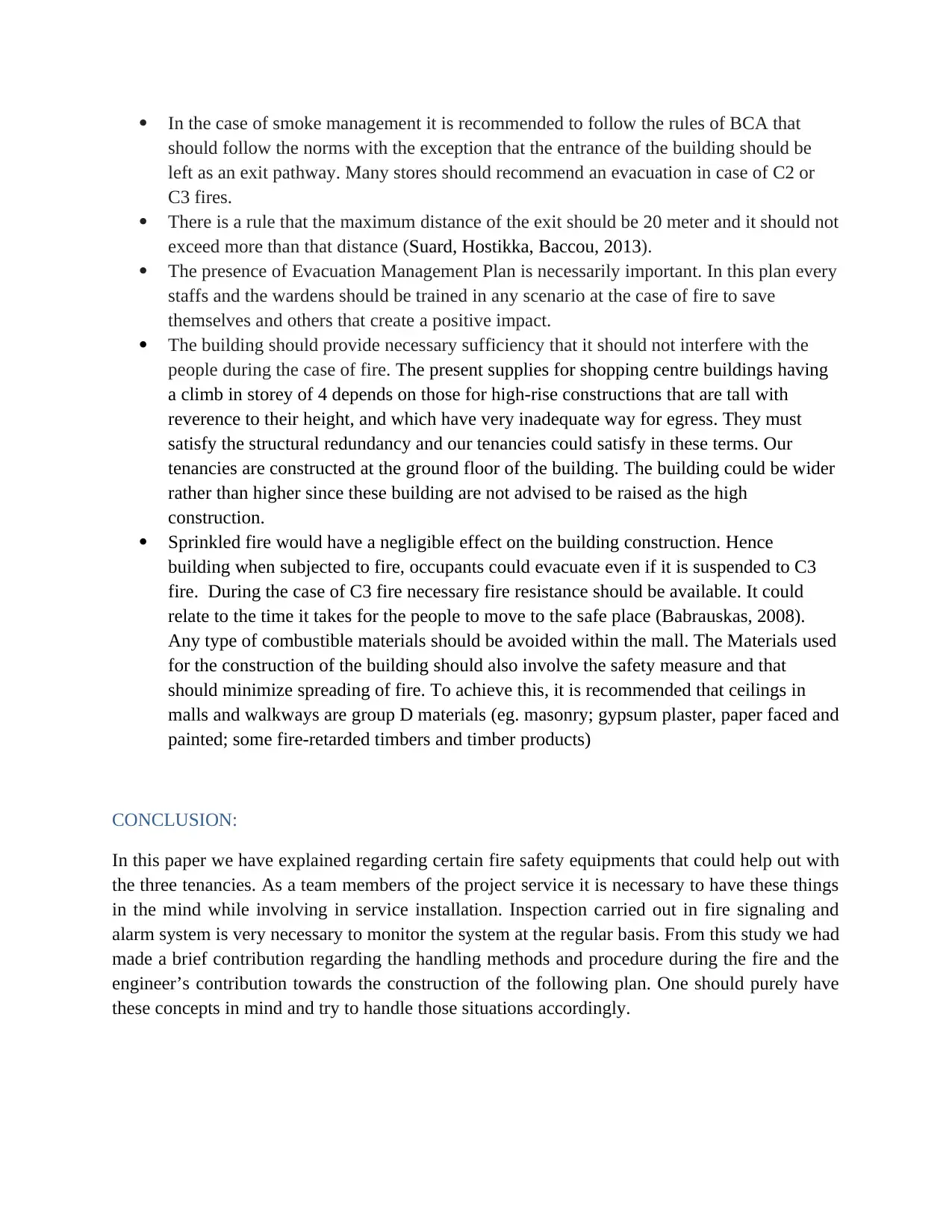
In the case of smoke management it is recommended to follow the rules of BCA that
should follow the norms with the exception that the entrance of the building should be
left as an exit pathway. Many stores should recommend an evacuation in case of C2 or
C3 fires.
There is a rule that the maximum distance of the exit should be 20 meter and it should not
exceed more than that distance (Suard, Hostikka, Baccou, 2013).
The presence of Evacuation Management Plan is necessarily important. In this plan every
staffs and the wardens should be trained in any scenario at the case of fire to save
themselves and others that create a positive impact.
The building should provide necessary sufficiency that it should not interfere with the
people during the case of fire. The present supplies for shopping centre buildings having
a climb in storey of 4 depends on those for high-rise constructions that are tall with
reverence to their height, and which have very inadequate way for egress. They must
satisfy the structural redundancy and our tenancies could satisfy in these terms. Our
tenancies are constructed at the ground floor of the building. The building could be wider
rather than higher since these building are not advised to be raised as the high
construction.
Sprinkled fire would have a negligible effect on the building construction. Hence
building when subjected to fire, occupants could evacuate even if it is suspended to C3
fire. During the case of C3 fire necessary fire resistance should be available. It could
relate to the time it takes for the people to move to the safe place (Babrauskas, 2008).
Any type of combustible materials should be avoided within the mall. The Materials used
for the construction of the building should also involve the safety measure and that
should minimize spreading of fire. To achieve this, it is recommended that ceilings in
malls and walkways are group D materials (eg. masonry; gypsum plaster, paper faced and
painted; some fire-retarded timbers and timber products)
CONCLUSION:
In this paper we have explained regarding certain fire safety equipments that could help out with
the three tenancies. As a team members of the project service it is necessary to have these things
in the mind while involving in service installation. Inspection carried out in fire signaling and
alarm system is very necessary to monitor the system at the regular basis. From this study we had
made a brief contribution regarding the handling methods and procedure during the fire and the
engineer’s contribution towards the construction of the following plan. One should purely have
these concepts in mind and try to handle those situations accordingly.
should follow the norms with the exception that the entrance of the building should be
left as an exit pathway. Many stores should recommend an evacuation in case of C2 or
C3 fires.
There is a rule that the maximum distance of the exit should be 20 meter and it should not
exceed more than that distance (Suard, Hostikka, Baccou, 2013).
The presence of Evacuation Management Plan is necessarily important. In this plan every
staffs and the wardens should be trained in any scenario at the case of fire to save
themselves and others that create a positive impact.
The building should provide necessary sufficiency that it should not interfere with the
people during the case of fire. The present supplies for shopping centre buildings having
a climb in storey of 4 depends on those for high-rise constructions that are tall with
reverence to their height, and which have very inadequate way for egress. They must
satisfy the structural redundancy and our tenancies could satisfy in these terms. Our
tenancies are constructed at the ground floor of the building. The building could be wider
rather than higher since these building are not advised to be raised as the high
construction.
Sprinkled fire would have a negligible effect on the building construction. Hence
building when subjected to fire, occupants could evacuate even if it is suspended to C3
fire. During the case of C3 fire necessary fire resistance should be available. It could
relate to the time it takes for the people to move to the safe place (Babrauskas, 2008).
Any type of combustible materials should be avoided within the mall. The Materials used
for the construction of the building should also involve the safety measure and that
should minimize spreading of fire. To achieve this, it is recommended that ceilings in
malls and walkways are group D materials (eg. masonry; gypsum plaster, paper faced and
painted; some fire-retarded timbers and timber products)
CONCLUSION:
In this paper we have explained regarding certain fire safety equipments that could help out with
the three tenancies. As a team members of the project service it is necessary to have these things
in the mind while involving in service installation. Inspection carried out in fire signaling and
alarm system is very necessary to monitor the system at the regular basis. From this study we had
made a brief contribution regarding the handling methods and procedure during the fire and the
engineer’s contribution towards the construction of the following plan. One should purely have
these concepts in mind and try to handle those situations accordingly.
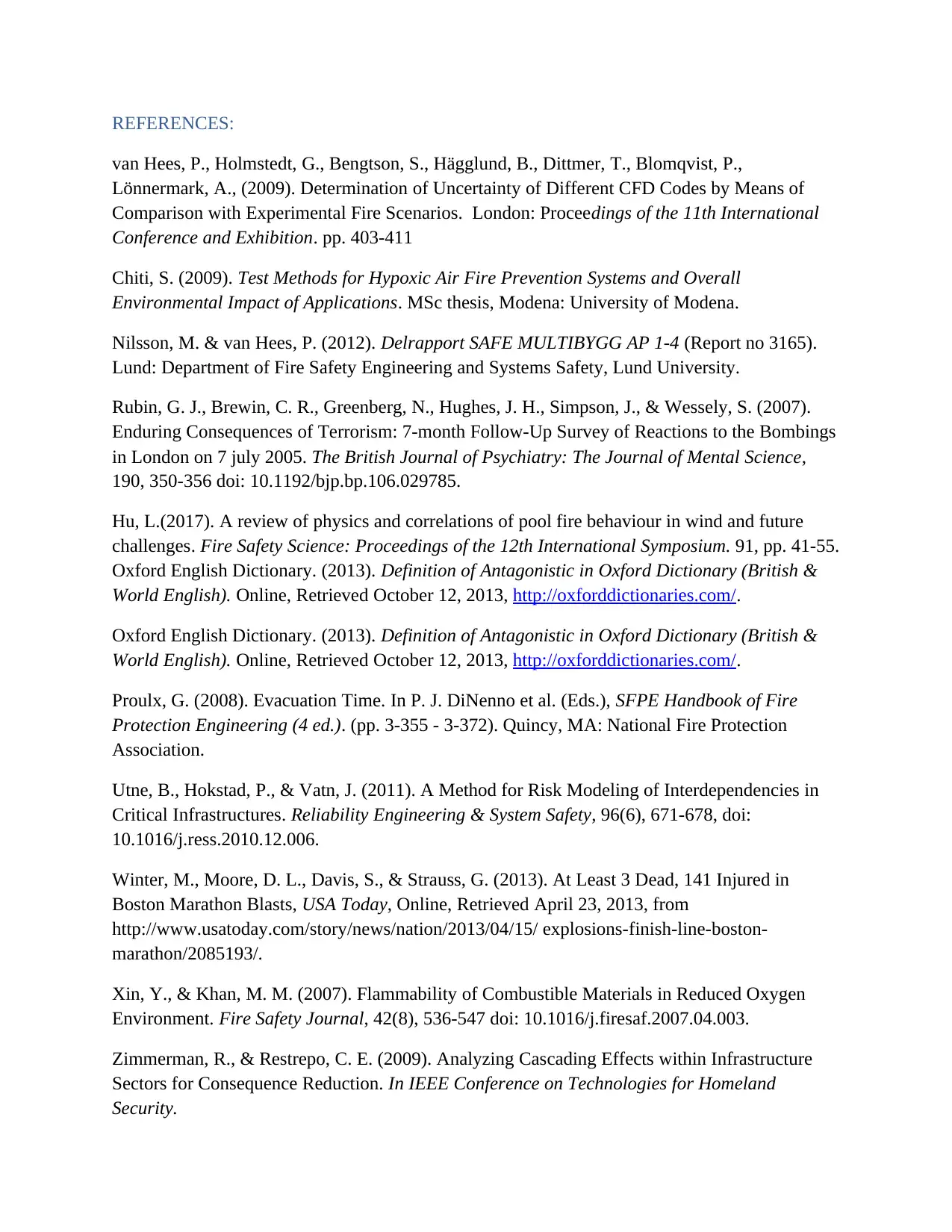
REFERENCES:
van Hees, P., Holmstedt, G., Bengtson, S., Hägglund, B., Dittmer, T., Blomqvist, P.,
Lönnermark, A., (2009). Determination of Uncertainty of Different CFD Codes by Means of
Comparison with Experimental Fire Scenarios. London: Proceedings of the 11th International
Conference and Exhibition. pp. 403-411
Chiti, S. (2009). Test Methods for Hypoxic Air Fire Prevention Systems and Overall
Environmental Impact of Applications. MSc thesis, Modena: University of Modena.
Nilsson, M. & van Hees, P. (2012). Delrapport SAFE MULTIBYGG AP 1-4 (Report no 3165).
Lund: Department of Fire Safety Engineering and Systems Safety, Lund University.
Rubin, G. J., Brewin, C. R., Greenberg, N., Hughes, J. H., Simpson, J., & Wessely, S. (2007).
Enduring Consequences of Terrorism: 7-month Follow-Up Survey of Reactions to the Bombings
in London on 7 july 2005. The British Journal of Psychiatry: The Journal of Mental Science,
190, 350-356 doi: 10.1192/bjp.bp.106.029785.
Hu, L.(2017). A review of physics and correlations of pool fire behaviour in wind and future
challenges. Fire Safety Science: Proceedings of the 12th International Symposium. 91, pp. 41-55.
Oxford English Dictionary. (2013). Definition of Antagonistic in Oxford Dictionary (British &
World English). Online, Retrieved October 12, 2013, http://oxforddictionaries.com/.
Oxford English Dictionary. (2013). Definition of Antagonistic in Oxford Dictionary (British &
World English). Online, Retrieved October 12, 2013, http://oxforddictionaries.com/.
Proulx, G. (2008). Evacuation Time. In P. J. DiNenno et al. (Eds.), SFPE Handbook of Fire
Protection Engineering (4 ed.). (pp. 3-355 - 3-372). Quincy, MA: National Fire Protection
Association.
Utne, B., Hokstad, P., & Vatn, J. (2011). A Method for Risk Modeling of Interdependencies in
Critical Infrastructures. Reliability Engineering & System Safety, 96(6), 671-678, doi:
10.1016/j.ress.2010.12.006.
Winter, M., Moore, D. L., Davis, S., & Strauss, G. (2013). At Least 3 Dead, 141 Injured in
Boston Marathon Blasts, USA Today, Online, Retrieved April 23, 2013, from
http://www.usatoday.com/story/news/nation/2013/04/15/ explosions-finish-line-boston-
marathon/2085193/.
Xin, Y., & Khan, M. M. (2007). Flammability of Combustible Materials in Reduced Oxygen
Environment. Fire Safety Journal, 42(8), 536-547 doi: 10.1016/j.firesaf.2007.04.003.
Zimmerman, R., & Restrepo, C. E. (2009). Analyzing Cascading Effects within Infrastructure
Sectors for Consequence Reduction. In IEEE Conference on Technologies for Homeland
Security.
van Hees, P., Holmstedt, G., Bengtson, S., Hägglund, B., Dittmer, T., Blomqvist, P.,
Lönnermark, A., (2009). Determination of Uncertainty of Different CFD Codes by Means of
Comparison with Experimental Fire Scenarios. London: Proceedings of the 11th International
Conference and Exhibition. pp. 403-411
Chiti, S. (2009). Test Methods for Hypoxic Air Fire Prevention Systems and Overall
Environmental Impact of Applications. MSc thesis, Modena: University of Modena.
Nilsson, M. & van Hees, P. (2012). Delrapport SAFE MULTIBYGG AP 1-4 (Report no 3165).
Lund: Department of Fire Safety Engineering and Systems Safety, Lund University.
Rubin, G. J., Brewin, C. R., Greenberg, N., Hughes, J. H., Simpson, J., & Wessely, S. (2007).
Enduring Consequences of Terrorism: 7-month Follow-Up Survey of Reactions to the Bombings
in London on 7 july 2005. The British Journal of Psychiatry: The Journal of Mental Science,
190, 350-356 doi: 10.1192/bjp.bp.106.029785.
Hu, L.(2017). A review of physics and correlations of pool fire behaviour in wind and future
challenges. Fire Safety Science: Proceedings of the 12th International Symposium. 91, pp. 41-55.
Oxford English Dictionary. (2013). Definition of Antagonistic in Oxford Dictionary (British &
World English). Online, Retrieved October 12, 2013, http://oxforddictionaries.com/.
Oxford English Dictionary. (2013). Definition of Antagonistic in Oxford Dictionary (British &
World English). Online, Retrieved October 12, 2013, http://oxforddictionaries.com/.
Proulx, G. (2008). Evacuation Time. In P. J. DiNenno et al. (Eds.), SFPE Handbook of Fire
Protection Engineering (4 ed.). (pp. 3-355 - 3-372). Quincy, MA: National Fire Protection
Association.
Utne, B., Hokstad, P., & Vatn, J. (2011). A Method for Risk Modeling of Interdependencies in
Critical Infrastructures. Reliability Engineering & System Safety, 96(6), 671-678, doi:
10.1016/j.ress.2010.12.006.
Winter, M., Moore, D. L., Davis, S., & Strauss, G. (2013). At Least 3 Dead, 141 Injured in
Boston Marathon Blasts, USA Today, Online, Retrieved April 23, 2013, from
http://www.usatoday.com/story/news/nation/2013/04/15/ explosions-finish-line-boston-
marathon/2085193/.
Xin, Y., & Khan, M. M. (2007). Flammability of Combustible Materials in Reduced Oxygen
Environment. Fire Safety Journal, 42(8), 536-547 doi: 10.1016/j.firesaf.2007.04.003.
Zimmerman, R., & Restrepo, C. E. (2009). Analyzing Cascading Effects within Infrastructure
Sectors for Consequence Reduction. In IEEE Conference on Technologies for Homeland
Security.
⊘ This is a preview!⊘
Do you want full access?
Subscribe today to unlock all pages.

Trusted by 1+ million students worldwide
1 out of 13
Your All-in-One AI-Powered Toolkit for Academic Success.
+13062052269
info@desklib.com
Available 24*7 on WhatsApp / Email
![[object Object]](/_next/static/media/star-bottom.7253800d.svg)
Unlock your academic potential
Copyright © 2020–2025 A2Z Services. All Rights Reserved. Developed and managed by ZUCOL.


